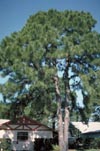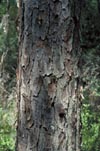Home >
Pinus palustris, Longleaf Pine
Longleaf Pine should be grown in full sun or partial shade on well-drained soil, acidic soil. Once established, trees are very drought-tolerant and require no irrigation for survival. Along with turkey oak and other dry site plants, it grows in hot dry conditions in the woods and would probably do well in the hot conditions created near concrete and asphalt. Like other pines dropping needles often discourage people from planting pines near streets, parking lots, or near other pavement. Roots also enjoy growing just under the surface of the asphalt and cracking it. Needles are in threes. If trees must be pruned in the western US, do it October through January to help avoid infestation from pitch moths. Plants once covered about 80 million acres in the southern US, but have now been reduced to about 10,000 acres!
Trees naturally occur throughout north Florida south to Lee and Indian River Counties.
Like many pines horizontal branches break easily in ice and wind storms. Something always seems to be falling from this pine tree; needles, sap, branches, and fruit appear on nearby cars, roofs and sidewalks year round. Unless grown in the open with no other trees nearby, shaded lower branches die as the tree grows taller. Open-grown trees keep more lower branches, probably due to greater sun exposure. It is important to maintain only one leader to the top of the plant. Pines are among those susceptible to summer branch drop according to surveys in California. Summer branch drop is a phenomena resulting in failure and breakage of large diameter, live branches typically on calm summer days.
Dropping
needles often discourage people from planting pines near streets, parking
lots, or near other pavement. Roots also enjoy growing just under the
surface of the asphalt and cracking it. Massive tap roots often develop
in their natural habitat where soils are deep and well-drained. Probably
the most serious problem of Pines in areas with high pH irrigation water
is pine chlorosis. The root system is often dominated by a few large diameter
roots. Wood weighs about 60 pounds per cubic foot.





